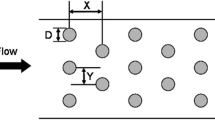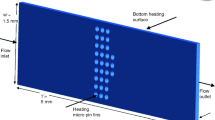Abstract
One way to cool gas turbine tips is to design serpentine passages with 180° turns inside the blades to fully utilize the coolant potential. It is therefore a desire to improve the cooling of the blade tips to ensure a long durability and safe operation. In the present work, a two-pass channel with a 180° turn and various arrays of pin-fins mounted internally on the tip-cap is considered. The effects of pin-fin height, diameter and pitches on the heat transfer enhancement and pressure drop are investigated numerically. The nominal ratio of height to diameter (H/D) of the pin-fins is 2, and the ratio of tip clearance to pin-fin height is about 10. The inlet Reynolds numbers based on hydraulic diameter are ranging from 100,000 to 600,000. Details of the three dimensional fluid flow and heat transfer over the pin-finned tips are presented. The overall performances of various tips are compared. It is found that due to the combination of turning, impingement and pin-fin crossflow, the heat transfer coefficient of the pin-finned tips is up to a factor of 2.1 higher than that of the smooth tip. This augmentation is achieved at the expense of a penalty of pressure drop around 30%. Results show that the magnitude of the heat transfer enhancement depends upon pin-fin configuration and arrangement. It is suggested that pin-fins are suitable to enhance the blade tip heat transfer and thus to improve the tip cooling.












Similar content being viewed by others
Abbreviations
- A :
-
Wall surface area
- D :
-
Pin-fin diameter
- D h :
-
Hydraulic diameter
- f :
-
Fanning friction factor
- H :
-
Pin-fin height
- h :
-
Heat transfer coefficient
- k :
-
Turbulent kinetic energy
- N :
-
Number of pin-fins
- L :
-
Two-pass channel length
- Nu :
-
Nusselt number
- p :
-
Pressure
- Pr :
-
Prandtl number
- q w :
-
Wall heat flux
- Re :
-
Reynolds number, Re = ρu i D h/μ
- S :
-
Spanwise/transverse pin-fin pitch
- T :
-
Temperature
- u i :
-
Inlet velocity
- X :
-
Streamwise/longitudinal pin-fin pitch
- \( \varepsilon \) :
-
Rate of energy dissipation
- \( \Updelta p \) :
-
Pressure drop
- μ :
-
Fluid dynamic viscosity
- ρ :
-
Fluid density
- \( \lambda \) :
-
Fluid thermal conductivity
- 0:
-
Fully developed flow channel
- ave:
-
Averaged/overall
- b:
-
According to Bunker’s definition
- e:
-
Endwall of tip
- i:
-
Inlet
- o:
-
Outlet
- p:
-
Pin-fin
- s:
-
Smooth channel
- w:
-
Wall
References
Ekkad SV, Pamula G, Shantiniketanam M (2000) Detailed heat transfer measurements inside straight and tapered two-pass channels with rib turbulators. Exp Thermal Fluid Sci 22:155–163
Son SY, Kihm KD, Han JC (2002) PIV flow measurements for heat transfer characterization in two-pass square channels with smooth and 90° ribbed walls, Int. J Heat Mass Transf 45:4809–4822
Al-Hadhrami L, Griffith T, Han JC (2003) Heat transfer in two-pass rotating rectangular channels (AR = 2) with five different orientations of 45-deg V-shaped rib turbulators. ASME J Heat Transf 125:232–242
Astarita T, Cardone G, Carlomagno GM (2002) Convective heat transfer in ribbed channels with a 180° turn. Exp Fluids 33:90–100
Liou TM, Chen MY, Wang YM (2003) Heat transfer, fluid flow and pressure measurements inside a rotating two-pass duct with detached 90-deg ribs, ASME J. Turbomachinery 125:565–574
Liou TM, Hwang YS, Li YC (2006) Flowfield and pressure measurements in a rotating two-pass duct with staggered rounded ribs skewed 45-deg to the flow, ASME J. Turbomachinery 128:340–348
Fu WL, Wright LM, Han JC (2005) Heat transfer in two-pass rotating rectangular channels (AR = 1:2 and AR = 1:4) with 45-deg angled rib turbulators. ASME J Turbomach 127:164–174
Fu WL, Wright LM, Han JC (2006) Heat transfer in two-pass rotating rectangular channels (AR = 1:2) with discrete ribs. AIAA J Thermophys Heat Transf 20:569–582
Liu YH, Wright LM, Fu WL, Han JC (2007) Rib spacing effect on heat transfer in rotating two-pass ribbed channel, AIAA J. Thermophys Heat Transf 21:582–595
Kim YM, Lee DH, Cho HH (2007) Detailed measurement of heat/mass transfer and pressure drop in a rotating two-pass duct with transverse ribs. Heat Mass Transf 43:801–805
Kim YM, Lee DH, Rhee DH, Cho HH (2009) Heat (mass) transfer and friction loss in two-pass ducts with various parallel rib arrangements. Heat Mass Transf 45:783–792
Lee SW, Ahn HS, Lau SC (2007) Heat (mass) transfer distribution in a two-pass trapezoidal channel with a 180-deg turn. ASME J Heat Transf 129:1529–1537
Lucci JM, Amano RS, Guntur K (2007) Turbulent flow and heat transfer in variable geometry u-bend blade cooling passage, proceedings of GT2007, ASME turbo paper no. GT2007-27120
Jenkins SC, Zehnder F, Shevchuk IV (2008) The effect of ribs and tip wall distance on heat transfer for a varying aspect ratio two-pass ribbed internal cooling channel, proceedings of GT2008, ASME Turbo2008, paper no. GT2008-51270
Shevchuk IV, Jenkins SC, Zehnder F (2008) Validation and analysis of numerical results for a varying aspect ratio two-pass internal cooling channel, proceedings of GT2008, ASME turbo 2008, paper no. GT2008-51219
Metzger DE, Berry RA, Bronson JP (1982) Developing heat transfer in rectangular ducts with staggered arrays of short pin fins. ASME J Heat Transf 104:700–706
Lau SC, Kim YS, Han JC (1987) Local endwall heat/mass distributions in pin fin channels. AIAA J Thermophys 1:365–372
Chyu MK, Hsing YC, Shih TIP, Natarajan V (1999) Heat transfer contributions of pins and endwall in pin-fin arrars: effect of thermal boundary condition modeling. ASME J Turbomach 121:257–263
Goldstein RJ, Jabbari MY, Chen SB (1994) Convective mass transfer and pressure loss characteristics of staggered short pin-fin arrays. Int J Heat Mass Transf 37(Suppl. 1):149–160
Wright LM, Lee E, Han JC (2004) Effect of rotating on heat transfer in rectangular channels with pin fins, AIAA J. Thermophys Heat Transf 18:263–272
Ames FE, Dvorak LA, Morrow MJ (2005) Turbulent augmentation of internal convection over pins in staggered-pin fin arrays. ASME J Turbomach 127:183–190
Sahiti N, Lemouedda A, Stojkovic D, Durst F, Franz E (2006) Performance comparison of pin fin in-duct flow arrays with various pin cross-section. Appl Therm Eng 26:176–1192
Su GG, Chen HC, Han JC (2007) Computation of flow and heat transfer in rotating rectangular channels (AR = 4:1) with pin-fins by a reynolds stress turbulence model. ASME J Heat Transf 129:685–696
Chang SW, Yang TL, Huang CC, Chiang KF (2008) Endwall heat transfer and pressure drop in rectangular channels with attached and detached circular pin-fin array, Int J. Heat Mass Transf 51:5247–5259
Bunker RS (2007) The augmentation of internal blade tip-cap cooling by arrays of shaped pins, proceeding of GT2007, ASME turbo 2007: power for land, sea, air, May 14–17, Montreal, Canada, GT2007-27009
Xie GN, Sundén B, Wang LK, Utriainen E (2009) Enhanced internal heat transfer on the tip-wall in a rectangular two-pass channel by pin-fin arrays. Numer Heat Transf Part A 55:739–761
Xie GN, Sundén B, Wang LK, Utriainen E (2009) Augmented heat transfer of an internal blade tip wall with a pin-fin array, proceedings of ASME turbo expo 2009: power for land, sea and air, June 8–12, 2009, Orlando, Florida, USA, Paper no GT2009-59410
Choudhury D (1993) Introduction to the renormalization group method and turbulence modeling. Fluent Inc., Technical Memorandum TM-107
Acknowledgments
The authors acknowledge the financial support from the TURBO POWER consortium funded by the Swedish Energy Agency (STEM), Siemens Industrial Turbomachinery AB and Volvo Aero Corporation. The authors also acknowledge Dr R.S. Bunker (GE) for meaningful comments and suggestions.
Author information
Authors and Affiliations
Corresponding author
Rights and permissions
About this article
Cite this article
Xie, G., Sundén, B., Wang, L. et al. Parametric study on heat transfer enhancement and pressure drop of an internal blade tip-wall with pin-fin arrays. Heat Mass Transfer 47, 45–57 (2011). https://doi.org/10.1007/s00231-010-0671-x
Received:
Accepted:
Published:
Issue Date:
DOI: https://doi.org/10.1007/s00231-010-0671-x




